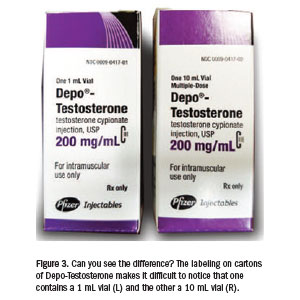Do Not Let “Depo-” Medications Be a Depot for Mistakes
Wrong strength Depo-Testosterone
ISMP has received reports regarding potential errors with Depo-Testosterone for which the wrong strength or volume of the drug might be administered to patients. This drug is available in two strengths: 100 mg/mL and 200 mg/mL. The 200 mg/mL strength is available in a 1 mL vial and a 10 mL vial. However, the vial sizes are extremely hard to differentiate when looking at the medication cartons (Figure 3). 
Wrong route Depo-Medrol
In late 2015, a patient received 100 mg of Depo-Medrol IV. The route of administration was not specified on the written order given to the nurse, who assumed the drug should be administered IV, like the other medications the patient was receiving. The nurse did not recall seeing the statement, “Not for IV Use” on the back of the vial label; the statement is in a very small font size. Fortunately, the patient was not harmed. The reporting pharmacist found many case reports of similar errors published in the literature.
Other errors involving Depo-Medrol being administered IV instead of intramuscularly have resulted from mix-ups between SOLU-MEDROL (methylPREDNISolone sodium succinate) and Depo-Medrol, often due to stocking errors. Depo-Medrol’s milky white appearance rarely gives pause anymore before administration given the wide variety of other cloudy or opaque medications that are administered IV.
Aggregate reports
Analysis of aggregate data regarding mix-ups between Depo-Medrol and Depo-Provera between 1999 and 2015 identified five additional cases reported to FAERS and four more reported to the ISMP MERP database, for a total of 11 reports. One of the events occurred as recently as December 2015, although no harm occurred when the patient received an injection of Depo-Medrol instead of Depo-Provera. Date ranges for the reported errors were distributed evenly between 1999 through 2015; therefore, we did not find any trends in the occurrence of the errors over time. In most of the cases (n=7), Depo-Provera was the intended drug and Depo-Medrol was administered instead. The errors occurred in a variety of settings, so it is difficult to associate patterns of error within a specific clinical setting (e.g., clinic vs. hospital). Five of the reports identified the Pfizer Depo-Medrol 80 mg/mL vials, and two involved the Pfizer Depo-Provera 150 mg/mL vials (both distributed by Pharmacia & Upjohn, a division of Pfizer). In four of the 11 cases, both products were available as unit stock. This may have contributed to errors due to the similarities in the names. For example, confusion may have occurred if staff misread the correct drug name when stocking the drug product (i.e., stocked in the wrong bin) and then the wrong drug was selected prior to administration, leading to a medication error. Other than name similarity, none of the reports identified container labels or carton labeling similarities as a contributing factor.
Another analysis of aggregate data regarding IV administration of a “Depo-“ medication shows that the most frequent wrong route errors were associated with Depo-Medrol (n=11 out of 12 total IV administrations). In five of these cases, the route of administration was misunderstood, and Depo-Medrol was administered intravenously. In the remaining six cases, Depo-Medrol was administered in error when the order was for IV Solu-MEDROL. It should be noted that there is also a product named DEPO-ESTRADIOL (estradiol cypionate), although we have only one error report for this drug indicating that it was given by the IV route instead of intramuscular route of administration.
The recent close calls associated with Depo-Testosterone (n=2) were both caused by volume or strength confusion due to look-alike labeling and packaging.
